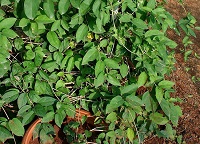Phytochemical analysis and antibacterial activity of Gymnema sylvestre leaf extracts
Keywords:
Gymnema sylvestre, Asclepiadaceae, Gymnemic acidsAbstract
During the last decade, the use of traditional medicine has expanded globally and is gaining popularity. Traditional medicines are used not only for primary health care of the poor in developing countries, but also in countries where conventional medicine is predominant in the national health care system. The herbal medicines serve the health needs of about 80% of the world’s population. Gymnema sylvestre is an herb native to the tropical forests of southern and central India and Sri Lanka. It belongs the family Asclepiadaceae. Chewing the leaves suppresses the sensation of sweet. This effect is attributed to the presence of the compound named as gymnemic acids. The results of present study clearly indicate the presence of different phytochemical compounds and antibacterial activity of the aqueous and methanolic extracts of leaves. The active compound of the plant is a group of acids termed as gymnemic acid. Secondary metabolites like alkaloids, terpenoids, phenolics, steroids and flavonoids play an important role in the plant activities. Presence of these compounds of plant which could be of considerable interest to the development of new drugs.
References
• Ibekwe VI, Ubochi KC, Anyanwu BN. Prevalence of Reniciclla Resistance in organisms that causes sexually transmitted in Port-Harcourt, Nigeria Ltd., Environmental health Res. 2000; 10: 251-255.
• Ikekwe VL, Nyanere NF, Akinjobi CO. Studies on antibacterial activity and Phytochemical qualities of extracts of orange peels, Int. J. E. ViroHerth and Human development. 2001; 2(1): 41-46.9.
• Kishor Naidu G, Chandra Sekhar Naidu K and B. Sujatha. In Vitro Antibacterial Activity and Phytochemical Analysis of Leaves of Gymnema sylvestre Retz. R. Br. Int.J.PharmTech Res. 2013; 5(3).
• Murugan M, Mohan VR, Thamodharan V. Phytochemical screening and antibacterial activity of Gymnema sylvestre (Retz) R. Br ex. Schultes and Morinda pubescens J.E. Smith var. pubescens. Journal of Applied Pharmaceutical Science. 2012; 02 (02); 73-76.
• Okigbo RN, Omodamiro OD. Antimicrobial effect of leaf extracts of Pigeon Pea (CajanuscajanL Mill sp) on some human pathogens. Journal of Herbs, Spices and Medicinal Plants. 2006; 12(1/2): 117–127.
• Tanaka H, Sato M, Fujiwara S. Antibacterial activity of isoflavonoids isolated from Erythrinavariegata against methicillin resistant Staphylococcus aureus. Letters in Applied Microbiology. 2002; 35: 228–489.



